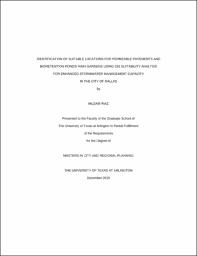
ATTENTION: The works hosted here are being migrated to a new repository that will consolidate resources, improve discoverability, and better show UTA's research impact on the global community. We will update authors as the migration progresses. Please see MavMatrix for more information.
Show simple item record
| dc.contributor.advisor | Anjomani, Ardeshir, PhD | |
| dc.contributor.author | Riaz, Muzaib | |
| dc.date.accessioned | 2019-10-29T15:43:41Z | |
| dc.date.available | 2019-10-29T15:43:41Z | |
| dc.date.issued | 2015-12 | |
| dc.identifier.uri | http://hdl.handle.net/10106/28753 | |
| dc.description.abstract | Low Impact Development (LID) Strategies have shown effectiveness in managing stormwater efficiently at its source. LID strategies can be utilized to manage storm water in coordination with conventional stormwater management infrastructure to increase efficiency and reduce flooding in case of extreme precipitation events. In this study GIS suitability analysis technique has been used to identify suitable locations for permeable pavements and bioretention ponds / rain gardens; two of the four main LID Best Management Practices (BMPs) within the City of Dallas. The Analytical Hierarchy Process (AHP) was used to determine weights of factors for suitability analysis. Case studies from Bryan - College Station, Texas, demonstrate the effectiveness of LID BMPs in managing stormwater specifically in Texas. | en_US |
| dc.language.iso | en_US | en_US |
| dc.publisher | University of Texas at Arlington | en_US |
| dc.subject | Dallas, Texas | en_US |
| dc.subject | stormwater management | en_US |
| dc.subject | permeable pavements | en_US |
| dc.title | Identification of Suitable Locations for Permeable Pavements and Bioretention Ponds / Rain Gardens Using GIS Suitability Analysis for Enhanced Stormwater Management Capacity in the City of Dallas | en_US |
| dc.type | Technical Report | en_US |
Files in this item
- Name:
- Identification of Suitable ...
- Size:
- 2.647Mb
- Format:
- PDF
- Description:
- Identification of Suitable ...
This item appears in the following Collection(s)
Show simple item record


